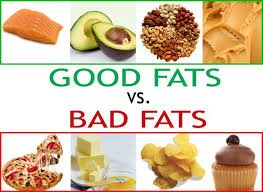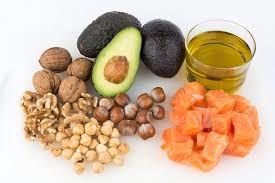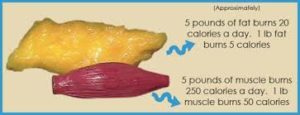Fat or Fiction?!
Fat – Oxford Dictionary definition: noun: a natural oily or greasy substance occurring in animal bodies, especially when deposited as a layer under the skin or around certain organs.
| Synonyms: fatty tissue, adipose tissue, cellulite, blubber, flab
Informal: spare tire, love handles
Fat – In Chemistry: any of a group of natural esters of glycerol and various fatty acids, which are solid at room temperature and are the main constituents of animal and vegetable fat. |
Fat is one of the three main macronutrients — which provide the bulk energy an organism’s metabolic system needs to function — along with carbohydrate and protein. Fats, also known as triglycerides, are chemical compounds of three fatty acid chains and alcohol glycerol. (Reference: Wikipedia)
Fat is a necessary food for many forms of life, and fats serve both structural and metabolic functions. Some fatty acids that are set free by the digestion of fats are called essential because they cannot be synthesized in the body from simpler elements. There are two essential fatty acids in human nutrition: alpha-linolenic acid (an omega-3 fatty acid) and linoleic acid (an omega-6 fatty acid). Other lipids needed by the body can be synthesized from these. Fats and other lipids are broken down in the body by enzymes called lipases produced in the pancreas.
“Fat” is a word with multiple meanings. Despite the differences between body fat and dietary fat, most people believe they are both bad. However, recent research has uncovered benefits to eating dietary fats such as polyunsaturated and monounsaturated fats, found in foods such as salmon, walnuts and avocados. The strong evidence led to changes in recommendations of dietary fat consumption in the recent 2015 Dietary Guidelines for Americans.
Fats and oils are categorized according to the number and bonding of the carbon atoms in the aliphatic chain. Fats that are saturated fats have no double bonds between the carbons in the chain. Unsaturated fats have one or more double bonded carbons in the chain. Some oils and fats have multiple double bonds and are therefore called polyunsaturated fats. Unsaturated fats can be altered by reaction with hydrogen effected by a catalyst. *This action, called hydrogenation, tends to break all the double bonds and makes a fully saturated fat. Liquid cis-unsaturated fats such as vegetable oils are hydrogenated to produce saturated fats, which have more desirable physical properties e.g., they melt at a desirable temperature (30–40 °C), and store well, whereas polyunsaturated oils go rancid when they react with oxygen in the air. However, trans fats are generated during hydrogenation as contaminants created by an unwanted side reaction on the catalyst during partial hydrogenation. *(Reference: The World’s Healthiest Foods)
 Saturated fats can stack themselves in a closely packed arrangement, so they can solidify easily and are typically solid at room temperature. For example, animal fats tallow and lard are high in saturated fatty acid content and are solids. Olive and linseed oils on the other hand are unsaturated and liquid. Fats serve both as energy sources for the body, and as stores for energy in excess of what the body needs immediately. Each gram of fat when burned or metabolized releases about 9 food calories. Fats are broken down in the healthy body to release their constituents, glycerol and fatty acids. Glycerol itself can be converted to glucose by the liver and so become a source of energy.
Saturated fats can stack themselves in a closely packed arrangement, so they can solidify easily and are typically solid at room temperature. For example, animal fats tallow and lard are high in saturated fatty acid content and are solids. Olive and linseed oils on the other hand are unsaturated and liquid. Fats serve both as energy sources for the body, and as stores for energy in excess of what the body needs immediately. Each gram of fat when burned or metabolized releases about 9 food calories. Fats are broken down in the healthy body to release their constituents, glycerol and fatty acids. Glycerol itself can be converted to glucose by the liver and so become a source of energy.
Consumers’ understanding of the differences between dietary fats and their role still need to evolve. The first step to embracing good dietary fats is to focus on a diet of nutrient-dense foods, and to replace saturated fats with unsaturated fats. Look for liquid oils and the good fats found in salmon, walnuts, chia, flax and avocados.
Not all fatty foods are created equal. While pizza, French fries and hamburgers can contribute to weight gain and deterioration of health, the dietetic community is learning that the overall nutritional content of these foods — not their saturated fat — is what is to blame. Research from 50 years ago found that saturated fatty acids raised LDL (bad) cholesterol levels. But a reevaluation of that research has shown that they raise HDL (good) cholesterol just as much, if not more, protecting the body from unhealthy cholesterol levels and heart disease. We need to look at total caloric content as well as quality of food to help our body’s immune system and cells to stay healthy. (Reference: www.everydayhealth.com)
You Need to Eat Fat to Burn Fat
Muscle vs. Fat: Common sense tells us a pound of muscle and a pound of fat have to weigh the same, but they do differ in density. This means if you look at five pounds of muscle and five pounds of fat side by side, the fat takes up more volume, or space, than the muscle. That is good to know when part of your goal is the lean look of muscle, not the flabby look of fat.
The first step in a successful diet and exercise program may be to forget about the scale for a while, to get people to think about how they are feeling, how their clothes are fitting, and how their body has changed. The focus should not just be the number on the scale. If we only did things to make ourselves weigh less, we wouldn’t necessarily be healthier. Other benefits of muscle: it is critical in improving bone density and helps prevent the loss of muscle mass that occurs with aging, allowing people to stay active as they get older.
If you want to lose weight, most of the fat that you eat should come from unsaturated sources, both monounsaturated and polyunsaturated. A list of foods that pack tons of nutrients include fish, seeds, nuts, leafy vegetables, olive oil, and avocados. Besides removing LDL cholesterol from arteries and promoting a healthier heart, unsaturated fat can help you burn fat big time without cutting calories.
A 2009 study in the British Journal of Nutrition, found that participants who consumed the most unsaturated fatty acids have lower body-mass indexes and less abdominal fat than those who consumed the least, because the former ate higher-quality foods. Not long ago, manufacturers marketed low-fat and no-fat everything, but it actually stripped our bodies of a much-needed nutrients. Low- and no-fat diet movements ended up increasing obesity rates. It turns out that fat provides a big component to the foods we love: Taste. When food manufacturers removed fat from their foods, in order to increase flavor, they had to load the foods with sugar and salt, which are inflammatory.
Fat Keeps You Full
Fat is not the easiest nutrient to digest, so it sticks around in the digestive system for more time than many other nutrients. Monounsaturated fats may also help stabilize blood sugar levels, according to Mayo Clinic. That means you feel full longer, and you won’t feel the stomach-growling urge to raid the refrigerator after mealtime. In fact, diets with high amounts of omega-3 fatty acids create a greater sense of fullness both immediately following and two hours after dinner than do meals with low levels of the fatty acids, according to a 2008 study from University of Navarra in Pamplona, Spain. It should come as no surprise, then, that dieters who consume moderate levels of fat are more likely to stick with their eating plans than dieters who consume low levels of fat. (Reference: www.livestrong.com/eat-fat-to-burn-fat)
Let our Fitness Nutrition Specialists here at moreFIT help you with food plans that include a healthy balance of all the macronutrients.


